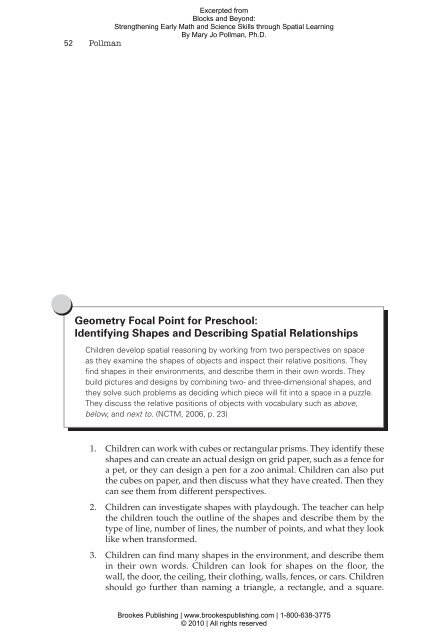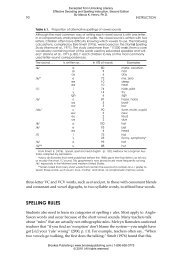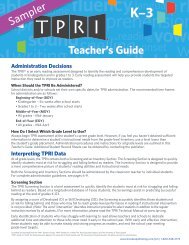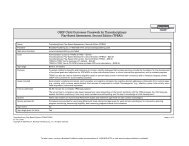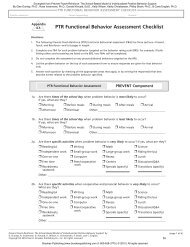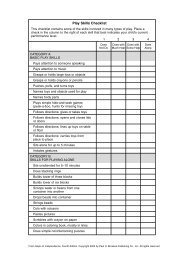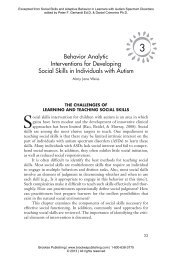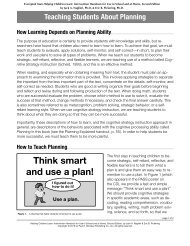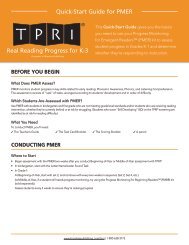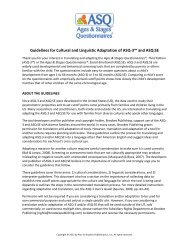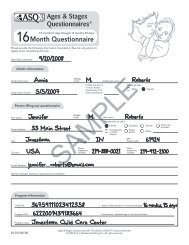ideas on teaching geometry during the school day - Brookes ...
ideas on teaching geometry during the school day - Brookes ...
ideas on teaching geometry during the school day - Brookes ...
Create successful ePaper yourself
Turn your PDF publications into a flip-book with our unique Google optimized e-Paper software.
Excerpted from<br />
Blocks and Bey<strong>on</strong>d:<br />
Streng<strong>the</strong>ning Early Math and Science Skills through Spatial Learning<br />
By Mary Jo Pollman, Ph.D.<br />
52 Pollman<br />
Piagetian Thoughts <strong>on</strong> Pre<strong>school</strong>ers’<br />
and Kindergartners’ Spatial Development<br />
Pre<strong>school</strong>ers and kindergartners are in <strong>the</strong> preoperati<strong>on</strong>al stage, according to<br />
Piaget (1959). They are still bound to <strong>the</strong>ir percepti<strong>on</strong>s and usually see things<br />
from <strong>on</strong>ly <strong>on</strong>e perspective. They like to focus <strong>on</strong> <strong>on</strong>ly <strong>on</strong>e aspect of a thing,<br />
so <strong>the</strong>y can be deceived by appearances. Pre<strong>school</strong>ers and kindergartners<br />
have not yet learned to c<strong>on</strong>serve space in <strong>the</strong> preoperati<strong>on</strong>al stage of Piaget<br />
(Piaget, 1959; Piaget, Inhelder, & Szeminska, 1960). When six cars are represented<br />
in a parking lot spread out <strong>on</strong> a 10-inch × 10-inch lot, a typical pre<strong>school</strong>er<br />
or kindergartner says that <strong>the</strong>re are more cars than if <strong>the</strong> cars are<br />
shown close toge<strong>the</strong>r <strong>on</strong> <strong>the</strong> same size parking lot. When <strong>the</strong> child is asked<br />
by <strong>the</strong> teacher, “Is <strong>the</strong>re more cement <strong>on</strong> <strong>the</strong> lot with <strong>the</strong> cars spread out or<br />
more with <strong>the</strong> cars close toge<strong>the</strong>r?” <strong>the</strong> child usually answers that <strong>the</strong>re is more<br />
cement when <strong>the</strong> cars are close toge<strong>the</strong>r. This child cannot c<strong>on</strong>serve number<br />
or space. According to Piaget (1959), in <strong>the</strong> preoperati<strong>on</strong>al stage, children are<br />
still using intuitive thought ra<strong>the</strong>r than logic. This intuitive thought is prevalent<br />
in young children’s thinking about spatial development. The good news<br />
is that, with teacher guidance, <strong>the</strong> child can progress to a higher degree than<br />
was <strong>on</strong>ce thought. The following activities will support children in <strong>the</strong>ir enhancement<br />
of spatial skills:<br />
Geometry Focal Point for Pre<strong>school</strong>:<br />
Identifying Shapes and Describing Spatial Relati<strong>on</strong>ships<br />
Children develop spatial reas<strong>on</strong>ing by working from two perspectives <strong>on</strong> space<br />
as <strong>the</strong>y examine <strong>the</strong> shapes of objects and inspect <strong>the</strong>ir relative positi<strong>on</strong>s. They<br />
find shapes in <strong>the</strong>ir envir<strong>on</strong>ments, and describe <strong>the</strong>m in <strong>the</strong>ir own words. They<br />
build pictures and designs by combining two- and three-dimensi<strong>on</strong>al shapes, and<br />
<strong>the</strong>y solve such problems as deciding which piece will fit into a space in a puzzle.<br />
They discuss <strong>the</strong> relative positi<strong>on</strong>s of objects with vocabulary such as above,<br />
below, and next to. (NCTM, 2006, p. 23)<br />
1. Children can work with cubes or rectangular prisms. They identify <strong>the</strong>se<br />
shapes and can create an actual design <strong>on</strong> grid paper, such as a fence for<br />
a pet, or <strong>the</strong>y can design a pen for a zoo animal. Children can also put<br />
<strong>the</strong> cubes <strong>on</strong> paper, and <strong>the</strong>n discuss what <strong>the</strong>y have created. Then <strong>the</strong>y<br />
can see <strong>the</strong>m from different perspectives.<br />
2. Children can investigate shapes with playdough. The teacher can help<br />
<strong>the</strong> children touch <strong>the</strong> outline of <strong>the</strong> shapes and describe <strong>the</strong>m by <strong>the</strong><br />
type of line, number of lines, <strong>the</strong> number of points, and what <strong>the</strong>y look<br />
like when transformed.<br />
3. Children can find many shapes in <strong>the</strong> envir<strong>on</strong>ment, and describe <strong>the</strong>m<br />
in <strong>the</strong>ir own words. Children can look for shapes <strong>on</strong> <strong>the</strong> floor, <strong>the</strong><br />
wall, <strong>the</strong> door, <strong>the</strong> ceiling, <strong>the</strong>ir clothing, walls, fences, or cars. Children<br />
should go fur<strong>the</strong>r than naming a triangle, a rectangle, and a square.<br />
<strong>Brookes</strong> Publishing | www.brookespublishing.com | 1-800-638-3775<br />
© 2010 | All rights reserved
Excerpted from<br />
Blocks and Bey<strong>on</strong>d:<br />
Streng<strong>the</strong>ning Early Math and Science Skills through Spatial Learning<br />
By Mary Jo Pollman, Ph.D.<br />
Spatial Development and Math 53<br />
Figure 3.8.<br />
Find three triangles in <strong>on</strong>e triangle.<br />
They should see that not all triangles are equilateral and discuss in<br />
depth <strong>the</strong> attributes of <strong>the</strong> shapes so that language development is taking<br />
place and explanati<strong>on</strong>s are precise. The teacher needs to describe,<br />
for example, <strong>the</strong> roundness of <strong>the</strong> bird’s nest, <strong>the</strong> round peas, and <strong>the</strong><br />
round cherry. The teacher describes <strong>the</strong> triangle mountain tip, <strong>the</strong> triangle<br />
shark’s fin, and <strong>the</strong> triangular ear of <strong>the</strong> cat. The teacher asks <strong>the</strong><br />
children what <strong>the</strong>y can build with two triangles. The teacher <strong>the</strong>n asks<br />
<strong>the</strong> students to name three shapes <strong>the</strong>y can build with three triangles.<br />
The students decide what shape fits into a space.<br />
4. The teacher asks <strong>the</strong> children to fold a square in half. The teacher <strong>the</strong>n<br />
asks <strong>the</strong> children what shape <strong>the</strong>y have created. The teacher asks <strong>the</strong><br />
students what kind of origami animal could be made with three tri angular<br />
folds. This beginning origami is very difficult for children in pre<strong>school</strong>.<br />
Folding from <strong>on</strong>e point to ano<strong>the</strong>r is ra<strong>the</strong>r difficult for most<br />
pre<strong>school</strong>ers in <strong>the</strong> United States because <strong>the</strong>y have not had much experience<br />
in paper folding. Children from Asian countries have many<br />
origami projects that <strong>the</strong>y learn at home and <strong>school</strong>. I observed young<br />
children in Japan performing this activity with ease. The children can<br />
easily fold <strong>the</strong> square into a rectangle. It might be helpful to dem<strong>on</strong>strate<br />
how a square can be turned into two triangles.<br />
5. The teacher can have students play a game called Guess What <strong>the</strong> Shape<br />
Is at circle time and bring <strong>the</strong> shapes out of an apr<strong>on</strong>. Play this with<br />
three-dimensi<strong>on</strong>al shapes and with flat shapes.<br />
6. The teacher can ask <strong>the</strong> students to find three triangles in <strong>on</strong>e triangle<br />
(see Figure 3.8).<br />
7. The teacher can ask <strong>the</strong> students to build different things with two triangles.<br />
8. Students can be asked to find smaller circles in larger circles. Make a 10-<br />
inch circle <strong>on</strong> paper, and let children use paint with cans and place circles<br />
within <strong>the</strong> large circle. Repeat this with o<strong>the</strong>r two dimensi<strong>on</strong>al shapes.<br />
<strong>Brookes</strong> Publishing | www.brookespublishing.com | 1-800-638-3775<br />
© 2010 | All rights reserved
Excerpted from<br />
Blocks and Bey<strong>on</strong>d:<br />
Streng<strong>the</strong>ning Early Math and Science Skills through Spatial Learning<br />
By Mary Jo Pollman, Ph.D.<br />
54 Pollman<br />
9. The children can discuss <strong>the</strong> relative size of <strong>the</strong> objects using simple adjectives,<br />
such as large, big, small, and little. Using butt<strong>on</strong>s that are large<br />
and round and small and round, and large and square and small and<br />
square, <strong>the</strong>y can complete an activity helping a teddy bear find its butt<strong>on</strong>s.<br />
The teacher can ask <strong>the</strong> following questi<strong>on</strong>: “Can you help <strong>the</strong><br />
teddy bear find <strong>on</strong>e large butt<strong>on</strong> and <strong>on</strong>e small butt<strong>on</strong>?” Even though<br />
sorting by color is <strong>the</strong> first way most pre<strong>school</strong>ers learn, sorting by color<br />
sometimes takes away from <strong>the</strong> spatial sense of words because children<br />
focus <strong>on</strong> <strong>the</strong> color.<br />
10. Using a grid, such as <strong>the</strong> <strong>on</strong>e in Appendix B in <strong>the</strong> back of <strong>the</strong> book,<br />
<strong>the</strong> children can visualize what is happening with cubes, rectangles, tri -<br />
angles, and prisms as <strong>the</strong>y place <strong>the</strong>m <strong>on</strong> <strong>the</strong> grid. The grid helps <strong>the</strong><br />
children structure <strong>the</strong>ir learning and later can lead into learning about<br />
coordinates.<br />
11. Students can sort three-dimensi<strong>on</strong>al figures by size, number of sides or<br />
vertices, and weight, and precisely describe <strong>the</strong> characteristics. Weight<br />
and graphs should be related to extensive language in math whereby<br />
size, shape, and quantity can be described (c<strong>on</strong>necti<strong>on</strong> to data analysis).<br />
12. Students can determine how many sides a shape has (c<strong>on</strong>necti<strong>on</strong> to<br />
number and operati<strong>on</strong>s).<br />
13. Students can develop simple sequential patterns, such as triangle, tri -<br />
angle, and square (AAB) or triangle, square, and square (ABB) (c<strong>on</strong>necti<strong>on</strong><br />
to algebra).<br />
14. Students can play with puzzles of all types, starting with small puzzles<br />
of two or three pieces and moving into complex puzzles. The teacher’s<br />
role is to give some guidance if needed but not to show exactly how to<br />
perform <strong>the</strong> activity. After using picture puzzles, <strong>the</strong> children can work<br />
<strong>on</strong> shape puzzles using various shapes to make a picture.<br />
15. Many books, such as All About Where and Over, Under and Through and<br />
O<strong>the</strong>r Spatial C<strong>on</strong>cepts by Hoban (1973) can be used to discuss positi<strong>on</strong><br />
words and phrases, such as under, above, below, and next to. There are<br />
o<strong>the</strong>r books <strong>on</strong> positi<strong>on</strong> words in Appendix F.<br />
Kindergarten Focal Points in<br />
Geometry: Describing Shapes and Space<br />
Children interpret <strong>the</strong> physical world with geometric <str<strong>on</strong>g>ideas</str<strong>on</strong>g> (e.g., shape, orien -<br />
tati<strong>on</strong>, spatial relati<strong>on</strong>s) and describe it with corresp<strong>on</strong>ding vocabulary. They<br />
identify, name, and describe a variety of shapes, such as squares, triangles, circles,<br />
rectangles, (regular) hexag<strong>on</strong>s, and (isosceles) trapezoids presented in a<br />
variety of ways (e.g., with different sizes or orientati<strong>on</strong>s), as well as such threedimensi<strong>on</strong>al<br />
shapes as spheres, cubes, and cylinders. They use basic shapes and<br />
spatial reas<strong>on</strong>ing to model objects in <strong>the</strong>ir envir<strong>on</strong>ment and to c<strong>on</strong>struct more<br />
complex shapes. (NCTM, 2006, p. 24)<br />
<strong>Brookes</strong> Publishing | www.brookespublishing.com | 1-800-638-3775<br />
© 2010 | All rights reserved
Excerpted from<br />
Blocks and Bey<strong>on</strong>d:<br />
Streng<strong>the</strong>ning Early Math and Science Skills through Spatial Learning<br />
By Mary Jo Pollman, Ph.D.<br />
Spatial Development and Math 55<br />
1. Children should be able to recognize basic geometric shapes of circle,<br />
triangle, square, rectangle, rhombus, and ellipse. Children should also be<br />
able to recognize examples of three-dimensi<strong>on</strong>al geometric shapes such<br />
as cylinder, cube, triangular prism, and rectangular prism. It should be<br />
noted that materials should include different types of triangles—not just<br />
equilateral triangles, because <strong>the</strong> equilateral triangle with <strong>the</strong> point up<br />
and horiz<strong>on</strong>tal base is <strong>the</strong> most comm<strong>on</strong> way children identify triangles.<br />
It is important to make sure to use different types of triangles such as <strong>the</strong><br />
right triangles with <strong>on</strong>e right angle, <strong>the</strong> equilateral triangle with all sides<br />
equal, <strong>the</strong> isosceles triangle with two c<strong>on</strong>gruent sides and two c<strong>on</strong>gruent<br />
angles, <strong>the</strong> scalene triangle with no c<strong>on</strong>gruent sides, <strong>the</strong> acute triangle<br />
with three acute angles, and <strong>the</strong> obtuse triangle with <strong>on</strong>e angle greater<br />
than 90 degrees and two angles less than 90 degrees. They should be rotated<br />
to present different viewpoints. The rectangles should include all<br />
sizes of rectangles—not just twice <strong>the</strong> size of a square.<br />
2. Children can sort three-dimensi<strong>on</strong>al figures by size, number of sides or<br />
vertices, or weight, and precisely describe <strong>the</strong> characteristics. Weight and<br />
graphs should be related to extensive language in math where size,<br />
shape, and quantity can be described (c<strong>on</strong>necti<strong>on</strong> to data analysis).<br />
3. Using large round and small round butt<strong>on</strong>s, and large square and small<br />
square butt<strong>on</strong>s, children can play a game where <strong>the</strong>y help a teddy bear<br />
find its butt<strong>on</strong>s. The teacher can ask <strong>the</strong> students <strong>the</strong> following questi<strong>on</strong>:<br />
“Can you help <strong>the</strong> teddy bear find <strong>on</strong>e large square butt<strong>on</strong> and <strong>on</strong>e small<br />
round butt<strong>on</strong>?” Classifying by size and shape is harder than classifying<br />
by <strong>on</strong>e property, and kindergartners need to start thinking in this way.<br />
4. Children can sort three-dimensi<strong>on</strong>al objects that roll, three-dimensi<strong>on</strong>al<br />
objects with flat sides, three-dimensi<strong>on</strong>al objects with slanted sides, threedimensi<strong>on</strong>al<br />
objects with flat and slanted sides, three-dimensi<strong>on</strong>al objects<br />
with and without points, three-dimensi<strong>on</strong>al objects with square surfaces<br />
and/or rectangular surfaces, and three-dimensi<strong>on</strong>al objects that can and<br />
cannot stack easily. A Venn diagram could be used to represent some of<br />
<strong>the</strong>se <str<strong>on</strong>g>ideas</str<strong>on</strong>g>.<br />
5. Teachers can teach children space c<strong>on</strong>cepts, such as positi<strong>on</strong> words (<strong>on</strong>,<br />
off, <strong>on</strong> top of, below, beside, in fr<strong>on</strong>t of, in back of, by, next to, between), directi<strong>on</strong><br />
words (up, down, around, through, to, from, toward, away from, sideways,<br />
across, forward, to <strong>the</strong> right, to <strong>the</strong> left), distance words (near, far, close, far<br />
from), and organizati<strong>on</strong> and pattern words (place in a row, AB pattern, ABA<br />
pattern, ABBA pattern). Learning about <strong>the</strong>se c<strong>on</strong>cepts can also lend itself<br />
to having children perform movement activities with <strong>the</strong>ir bodies. By<br />
performing movement activities, children can integrate <strong>the</strong>ir understanding<br />
of <strong>geometry</strong>, measurement, and number by using <strong>the</strong> grid to go from<br />
<strong>on</strong>e place to ano<strong>the</strong>r and discussing how many steps to take to <strong>the</strong> left,<br />
how many to take to turn right, and how many steps to go forward. Then<br />
children can use <strong>the</strong> grid in Appendix B in <strong>the</strong> back of this book to show<br />
this because this prepares children to use coordinates <strong>on</strong> <strong>the</strong> grid.<br />
6. As children progress to using blocks as objects to make real structures in<br />
<strong>the</strong> envir<strong>on</strong>ment, <strong>the</strong>y can make houses, buildings, and furniture with<br />
<strong>Brookes</strong> Publishing | www.brookespublishing.com | 1-800-638-3775<br />
© 2010 | All rights reserved
Excerpted from<br />
Blocks and Bey<strong>on</strong>d:<br />
Streng<strong>the</strong>ning Early Math and Science Skills through Spatial Learning<br />
By Mary Jo Pollman, Ph.D.<br />
56 Pollman<br />
unit blocks. The teacher needs to help <strong>the</strong>m use technical language in<br />
block playing. For more specific informati<strong>on</strong> <strong>on</strong> block playing and vocabulary,<br />
see Chapter 8.<br />
7. The teacher can have students make up shape and locati<strong>on</strong> pictures. The<br />
students can make a picture so that a triangle is over a square and a circle<br />
is under <strong>the</strong> square.<br />
8. There are numerous books, such as Changes, Changes (Hutchins, 1987)<br />
and Round Trip (J<strong>on</strong>as, 1984) that help children with different orientati<strong>on</strong>s<br />
toward objects in <strong>the</strong> envir<strong>on</strong>ments. These books help <strong>the</strong> child with visualizati<strong>on</strong>.<br />
It Looked Like Spilt Milk (Shaw, 1947) helps children see shapes<br />
in clouds. See Children’s Literature List in Appendix F for more books <strong>on</strong><br />
spatial development.<br />
Piagetian Thoughts <strong>on</strong> First and<br />
Sec<strong>on</strong>d Graders’ Spatial Development<br />
By <strong>the</strong> end of <strong>the</strong> first grade, children are in <strong>the</strong> c<strong>on</strong>crete operati<strong>on</strong>al stage, according<br />
to Piaget (1959). As children approach age 7, <strong>the</strong>ir thinking becomes<br />
more logical. They mentally organize <strong>the</strong>ir thoughts. In <strong>the</strong> c<strong>on</strong>crete operati<strong>on</strong>al<br />
stage, children can usually understand <strong>the</strong> c<strong>on</strong>cept of c<strong>on</strong>servati<strong>on</strong> of<br />
space problem written above (Piaget, Inhelder, & Szeminska, 1960). The child<br />
at this stage also understands c<strong>on</strong>servati<strong>on</strong> of matter; for example, <strong>the</strong>y can<br />
tell clay is <strong>the</strong> same when it is pulled out from a pretend hamburger into a<br />
pretend hot dog. Most children of this age can also c<strong>on</strong>serve length, which<br />
gives <strong>the</strong>m <strong>the</strong> opportunity to understand measurement. For example, most<br />
children can see that four toothpicks that are in a straight line are <strong>the</strong> same<br />
length as four toothpicks that are in a wavy line. They can categorize and sort<br />
things, such as triangles, rectangles, and squares. With practice, children<br />
should also be able to compose and decompose geometric figures.<br />
First-Grade Focal Points in Geometry:<br />
Composing and Decomposing Geometric Shapes<br />
Children compose and decompose plane and solid figures (e.g., by putting two<br />
c<strong>on</strong>gruent isosceles triangles toge<strong>the</strong>r to make a rhombus), thus building an understanding<br />
of part–whole relati<strong>on</strong>ships as well as <strong>the</strong> properties of <strong>the</strong> original<br />
and composite shapes. As <strong>the</strong>y combine figures, <strong>the</strong>y recognize <strong>the</strong>y form different<br />
perspectives and orientati<strong>on</strong>s, describe <strong>the</strong>ir geometric attributes and properties,<br />
and determine how <strong>the</strong>y are alike and different, in <strong>the</strong> process developing a<br />
background for measurement and initial understandings of such properties as<br />
c<strong>on</strong>gruence and symmetry. (NCTM, 2006, p. 26)<br />
1. Children need to be c<strong>on</strong>stantly putting things toge<strong>the</strong>r and taking <strong>the</strong>m<br />
apart, because composing and decomposing is important to this first-grade<br />
Focal Point. Children should be able to take apart three-dimensi<strong>on</strong>al and<br />
<strong>Brookes</strong> Publishing | www.brookespublishing.com | 1-800-638-3775<br />
© 2010 | All rights reserved
Order Form BROOKES PUBLISHING • P.O. Box 10624, Baltimore, MD 21285-0624<br />
ABOUT YOU (write in your specialty and check <strong>on</strong>e field that best applies)<br />
Specialty<br />
Birth to Five K–12 Clinical/Medical Pers<strong>on</strong>nel 4-year College/Grad. Comm. College/Vocati<strong>on</strong>al Associati<strong>on</strong>/Foundati<strong>on</strong> Comm. Services<br />
Name<br />
Address<br />
residential<br />
City<br />
ZIP<br />
commercial<br />
Country<br />
State<br />
E-mail<br />
Yes! I want to receive e-mail about new titles and special offers. (Your e-mail address will not be shared with any o<strong>the</strong>r party.)<br />
We auto-c<strong>on</strong>firm all orders by mail; please provide an email address to receive c<strong>on</strong>firmati<strong>on</strong> of order and shipping.<br />
Qty Stock # Title Price<br />
PAYMENT METHOD<br />
Check enclosed (payable to <strong>Brookes</strong> Publishing Co.)<br />
Purchase Order attached (bill my instituti<strong>on</strong>)<br />
*Add 2% to product total for P.O. handling fee<br />
American Express (15 digits)<br />
Discover (16 digits)<br />
MasterCard (16 digits)<br />
Subtotal<br />
6% sales tax, MD <strong>on</strong>ly<br />
5% business tax (GST), CAN <strong>on</strong>ly<br />
P.O. customers: 2% of subtotal<br />
Shipping (see chart below)<br />
Total (in U.S. dollars)<br />
Visa (13 or 16 digits)<br />
Credit card account number __ __ __ __ __ __ __ __ __ __ __ __ __ __ __ __<br />
Security code (3 or 4 digit code <strong>on</strong> back of card): __ __ __ __<br />
Expirati<strong>on</strong> date __ __ /__ __ Signature<br />
C<strong>on</strong>venient ways to order:<br />
CALL toll-free 1-800-638-3775 M-F, 9 a.m. to 5 p.m. ET.; FAX 410-337-8539;<br />
MAIL order form to: <strong>Brookes</strong> Publishing Co., P.O. Box 10624, Baltimore, MD 21285-0624:<br />
ON-LINE www.brookespublishing.com<br />
M<strong>on</strong>ey-back guarantee! Ordering with <strong>Brookes</strong> is risk-free. If you are not completely satisfied, you may return books and videotapes within<br />
30 <strong>day</strong>s for a full credit of <strong>the</strong> purchase price (unless o<strong>the</strong>rwise indicated). Refunds will be issued for prepaid orders. Items must be returned in resalable<br />
c<strong>on</strong>diti<strong>on</strong>. All prices in U.S.A. dollars. Policies and prices subject to change without notice. Prices may be higher outside <strong>the</strong> U.S.A.<br />
STANDARD GROUND SHIPPING & HANDLING<br />
(For o<strong>the</strong>r shipping opti<strong>on</strong>s and rates, call 1-800-638-3775, in <strong>the</strong> U.S.A. and Canada, and 410-337-9580, worldwide.)<br />
C<strong>on</strong>tinental U.S.A. ** territories & protectorates † ; AK, HI & PR ‡<br />
For subtotal of<br />
Add*<br />
US$55.00 and under $6.49<br />
US$55.01 and over 12%<br />
**<br />
C<strong>on</strong>tinental U.S.A. orders ship via UPS Ground Delivery.<br />
†<br />
U.S.A. territories & protectorates orders ship via USPS.<br />
‡<br />
AK, HI, and PR please add an additi<strong>on</strong>al US$12.00. Orders ship via UPS Air.<br />
Please call or email for expedited shipping opti<strong>on</strong>s and rates.<br />
Canada<br />
For subtotal of<br />
Add*<br />
US$67.00 and under $9.99<br />
US$67.01 and over 15%<br />
Orders for Canada are c<strong>on</strong>solidated for shipping twice each m<strong>on</strong>th.<br />
For minimum shipping time, please place your orders by <strong>the</strong> 9th or<br />
24th of each m<strong>on</strong>th.<br />
*calculate percentage <strong>on</strong> subtotal<br />
03/10<br />
printed from www.brookespublishing.com


